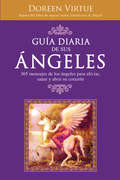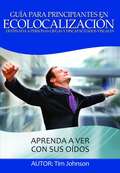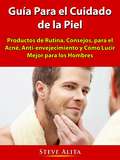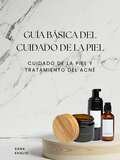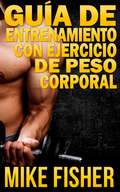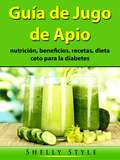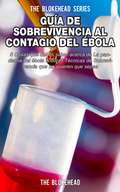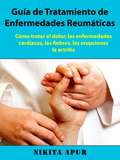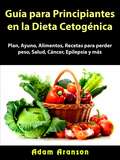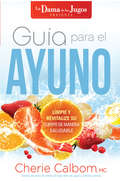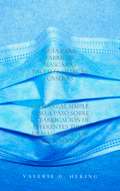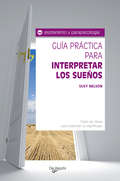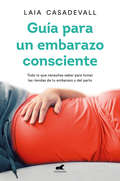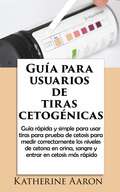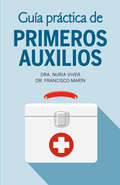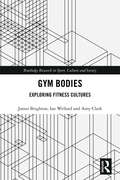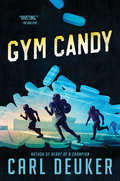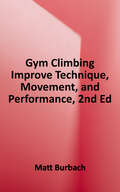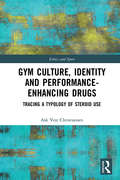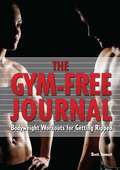- Table View
- List View
Guía Diaria de sus Ángeles
by Doreen VirtueBegin each morning by communing with your angels, using the 365 channeled meditations in this inspirational book. Each page offers a comforting and uplifting message that sets a positive and healing tone for the day. This material also functions as a divination tool, as you can ask a question and open the book to a thought that provides guidance, support, answers, and encouragement. Daily Guidance from Your Angels will keep you centered in peacefulness throughout the day, and will help you remember that your angels are always beside you, ready to assist you with every area of your life. A beautiful ribbon bookmark bound into the spine is the perfect way to easily mark your place, both morning and evening.
Guía Para Principiantes En Ecolocalización
by Timothy Johnson Gloria Cifuentes Dowling¿Es usted una persona ciega? ¿No lo es? En ambos casos puede aprender a "ver" usando sonidos en lugar de la vista. La ecolocalización es una habilidad sencilla que muchas personas ciegas utilizan a diario para desplazarse y comprender su entorno. En ocasiones puede ser mal interpretada, pero resulta mucho más realista y fácil de implementar de lo que se piensa. El autor desmitifica la creciente práctica de la ecolocalización activa a un nivel que cualquiera puede entender y ofrece al lector ejercicios, ejemplos y enseñanzas simples para que se inicie en una aplicación exitosa de esta habilidad. Las ondas sonoras, como el oleaje en un estanque, se reflejan de distinta manera en los objetos y superficies. Esto hace posible que un oído entrenado distinga la forma, el tamaño, la distancia y el material de los objetos a su alrededor. El músico nos dirá que la "reverberación" permite que cada recinto o superficie genere su propia respuesta sonora específica. Por medio de la sensibilización y de la práctica aplicada de esta habilidad, es posible que los discapacitados visuales de todo el mundo se vuelvan cada vez más independientes, complementando su manera actual de orientarse y de desplazarse con la percepción personal obtenida por medio de la ecolocalización. Para esto no se requiere ningún equipamiento especial ni talento específico. El cuerpo y la mente son verdaderas maravillas de la naturaleza que nos ofrecen capacidades insospechadas. Si podemos escuchar, podemos ecolocalizar. Comprender la simpleza de esta habilidad nos hará cambiar nuestra manera de pensar para dar lugar a una percepción enriquecida del entorno. Gracias a este nuevo nivel de conciencia llegaremos a ser más independientes y seguros y contaremos con nuevas posibilidades y oportunidades.
Guía Para el Cuidado de la Piel: Productos de Rutina, Consejos, para el Acné, Anti-envejecimiento y Cómo Lucir Mejor para los Hombres
by Steve AlitaGuía para el cuidado de la piel: Productos de rutina, consejos, para el acné, anti-envejecimiento y cómo lucir mejor para los hombres por Steve Alita ¡En esta guía aprenderás los consejos más efectivos y de bajo costo para transformarte en un modelo masculino! Estos métodos son comúnmente utilizados por los mejores modelos del mundo y pueden ser aplicados incluso por un principiante en tan sólo unos minutos. Guía de cuidado de la piel: productos de rutina, consejos, para el acné, antienvejecimiento, y buscando lo mejor para los hombres ¿Luchas con la piel imperfecta? ¿Le gustaría mejorar su apariencia? ¡En esta guía aprenderás los consejos más efectivos y de bajo costo para transformarte en un modelo masculino! Estos métodos son comúnmente utilizados por los mejores modelos del mundo y pueden ser aplicados incluso por un principiante en tan sólo unos minutos. Esto es lo que está incluido: - ¡Parezca más joven que nunca! - Consejos simples - Métodos de bajo costo - Cuida tu piel en pocos minutos cada día --> Desplácese hasta la parte superior de la página y haga clic en Añadir al carrito para comprar al instante. Descargo de responsabilidad: Este autor y/o propietario(s) de derechos no hace reclamos, promesas o garantías sobre la exactitud, integridad o adecuación de los contenidos de este libro, y expresamente niega responsabilidad por errores y omisiones en los contenidos dentro de este libro. Este producto es sólo para uso de referencia.
Guía básica del cuidado de la piel: Cuidado de la piel y tratamiento del acné
by Sana KhalidEsta guía de libro electrónico le enseñará: - Ingredientes para el cuidado de la piel respaldados por la ciencia - Formulaciones para el cuidado de la piel para pieles secas - Formulaciones para el cuidado de la piel para pieles grasas - Formulaciones para el cuidado de la piel para pieles mixtas
Guía de Comidas que Tratan Enfermedades
by Hiddenstuff Entertainment¿Le gustaría poder ayudar a eliminar enfermedades, molestias, inflamación, dolor, depresión y dolor? Durante mucho tiempo, se han utilizado técnicas naturales de curación para tratar una serie de dolencias! El uso de técnicas naturales de curación también ayudará con enfermedades crónicas, inflamación, su sistema inmunológico, niveles de energía, concentración, felicidad general, y mucho más! Presentamos los secretos que los profesionales de la curación natural usan para sentirse más saludables que nunca! Con décadas de estrategias probadas, este ebook le mostrará la manera más rápida y efectiva de utilizar la curación natural de su tiroides para beneficiar su bienestar! Usted aprenderá a aumentar su bienestar en tan sólo unas semanas. No sólo eso, sino que mejorará literalmente todos y cada uno de los aspectos de su vida. ¿Desea saber cómo manejan las personas las enfermedades y dolencias crónicas? Usted también puede aprender los secretos para lograr esto permitiéndole ser más feliz y saludable. Esta guía le enseña técnicas probadas sin el uso de costosos suplementos o cursos. Lo que está incluido: - Remedios. - Vencer a la enfermedad crónica. - Tenga más energía. - Duerma mejor. - Superar dolencias. - Nutrición. - Lo que usted debe saber. + MUCHO MÁS! Si quieres estar más saludable, curar dolencias o mejorar la concentración y el bienestar, esta guía es para ti. --> Desplácese hasta la parte superior de la página y haga clic en Añadir al carrito para comprar al instante. Descargo de responsabilidad: Este autor y/o propietario(s) de derechos no hace reclamos, promesas o garantías con respecto a la exactitud, integridad o adecuación del contenido de este libro, y expresamente niega responsabilidad por errores y omisiones en el contenido de este libro. Este producto es sólo
Guía de Entrenamiento con Ejercicio de Peso Corporal
by Mike Fisher Loreto GutiérrezRealiza una magnifica sesión de entrenamiento... estés donde estés, sin la necesidad de inscribirte en un gimnasio. Hacer ejercicio de forma regular es parte de un estilo de vida saludable, pero muchas personas utilizan excusas para evitar ejercitarse. Ya sea que tengas poco tiempo libre o que el bolsillo no te acompañe, de todas formas puedes lograr los resultados que deseas. ¿Tienes que viajar debido a tu trabajo? No te preocupes, puedes realizar estos ejercicios en la habitación de tu hotel. ¿No tienes tiempo? Perfecto, porque puedes ejercitarte cuando sí lo tengas, no solo en el horario de funcionamiento del gimnasio. Puedes lograr los resultados que deseas sin pagar la cuota de un gimnasio. ¿No quieres pagar la membrecía de un caro gimnasio? Fantástico, pues no necesitas de una. Todo lo que necesitas son unos simples ejercicios que puedes realizar en la comodidad de tu hogar. Ya tienes todo el "equipo" que necesitas: ¡tu cuerpo! Para realizar ejercicios de peso corporal sólo necesitas usar el peso de tu propio cuerpo como resistencia. Estos ejercicios pueden ayudarte a tonificar tu cuerpo y a aumentar tu fuerza y capacidad de resistencia. Además, los ejercicios de peso corporal son ideales para las personas que no se sienten a gusto en un gimnasio. La mayoría de los ejercicios de peso corporal no requieren del uso de equipo específico, ya que el peso de tu cuerpo actúa como la principal fuente de resistencia. Tonifica tu cuerpo con este plan de 8 semanas. Este libro describe varios ejercicios de peso corporal que trabajan diversos grupos musculares al mismo tiempo. De igual forma, incluye un plan de ejercicios de 8 semanas tanto para principiantes como para los niveles más avanzados. También encontrarás información sobre cómo incluir el ejercicio cardiovascular en tu rutina, además de información sobre nutrición para que puedas mejorar tu salud general. REGALO: Cuando adq
Guía de Jugo de Apio: nutrición, beneficios, recetas, dieta ceto para la diabetes
by Hiddenstuff Entertainment¡Cúrate y sé más saludable que nunca con jugo de apio! ¿Le gustaría poder ayudar a eliminar enfermedades, molestias, inflamación, dolor, depresión y dolor? ¡Durante mucho tiempo, el jugo de apio se ha utilizado para tratar varias dolencias! ¡Usar técnicas de curación natural también ayuda con enfermedades crónicas, inflamación, su sistema inmunológico, niveles de energía, concentración, felicidad general y mucho más! ¡Presentamos los secretos que los profesionales de la curación natural usan para sentirse más saludables que nunca! ¡Con décadas de estrategias probadas, este libro electrónico, la forma más rápida y efectiva de usar la curación natural con jugo de apio para el beneficiario de su bienestar! Aprenderá cómo aumentar su bienestar en tan solo unas pocas semanas. No solo eso, sino que mejorarás literalmente cada aspecto de tu vida. ¿Quiere saber cómo se enfrentan las personas con enfermedades y dolencias crónicas? Usted también puede aprender los secretos para lograr esto, permitirle ser más feliz y saludable. Esta guía le enseña técnicas comprobadas sin el uso de suplementos o cursos costosos. Qué está incluido: - Remedios de jugo de apio. - Batir la enfermedad crónica. - Tener más energía. - Duerme mejor. - Superar dolencias. - Nutrición. - Lo que deberías saber. + MUCHO MÁS
Guía de Sobrevivencia al Contagio del Ébola
by The BlokeheadCuando se trata de noticias sobre el virus del ebola, algunas personas tienen miedo de que el pais este en medio de una epidemia del ébola y no solo casos aislados del ébola. La verdad, algunas personas tienen miedo que una pandemia del ébola este a la vuelta de la esquina. Como resultado, las personas están buscando por todos los medios para encontrar mas información sobre lo que necesitan para protegerse y proteger a sus seres queridos.
Guía de tratamiento de Enfermedades Reumáticas: : Cómo tratar el dolor, las enfermedades cardíacas, las fiebres, las erupciones, la artritis
by Hiddenstuff EntertainmentGuía de tratamiento de enfermedades reumáticas: Cómo tratar el dolor, las enfermedades cardíacas, las fiebres, las erupciones, la artritis por Hiddenstuff Entertainment Guía de tratamiento de enfermedades reumáticas: Cómo tratar el dolor, las enfermedades cardíacas, las fiebres, las erupciones, la artritis Guía de tratamiento de enfermedades reumáticas: Cómo tratar el dolor, las enfermedades cardíacas, las fiebres, las erupciones, la artritis ¡Curar las enfermedades reumáticas y estar más sano que nunca! ¿Le gustaría poder ayudar a eliminar las enfermedades reumáticas, las molestias, la inflamación, el dolor, la depresión y el dolor? ¡Durante mucho tiempo, se han utilizado técnicas naturales de curación para tratar una serie de dolencias! El uso de técnicas naturales de curación no sólo ayudará con las enfermedades reumáticas, sino también con las enfermedades crónicas, la inflamación, el sistema inmunológico, los niveles de energía, la concentración, la felicidad general y mucho más. ¡Presentamos los secretos que los profesionales de la curación natural usan para sentirse más saludables que nunca! ¡Con décadas de estrategias probadas, este libro electrónico le mostrará la manera más rápida y efectiva de usar la curación natural para beneficiar su bienestar! Usted aprenderá a aumentar su bienestar en tan sólo unas semanas. No sólo eso, sino que mejorará literalmente todos y cada uno de los aspectos de su vida. ¿Desea saber cómo manejan las personas las enfermedades y dolencias crónicas? Usted también puede aprender los secretos para lograr esto, permitiéndole ser más feliz y saludable. Esta guía le enseña técnicas probadas sin el uso de costosos suplementos o cursos. Lo que está incluido: - Curar las enfermedades reumáticas. - Remedios Naturales. - Vencer a las enfermedades crónicas.
Guía para Principiantes en la Dieta Cetogénica: Plan, Ayuno, Alimentos, Recetas para perder peso, Salud, Cáncer, Epilepsia y más
by Hiddenstuff Entertainment¿Estás buscando perder peso y grasa corporal? ¿Estás buscando ser más saludable, fuerte y tener más energía? ¿Te gustaría poder ayudar a eliminar enfermedades, molestias, dolor y depresión? ¡Por un gran tiempo, la dieta cetogénica se ha utilizado para tratar numerosas molestias así como a facilitar la pérdida de peso! ¡Utilizar las técnicas de la dieta ceto también te ayudará con las enfermedades crónicas, inflamación, a tu sistema inmune, niveles de energía, concentración, y mucho más! ¡Presentamos los secretos que los profesionales de la curación natural utilizan para sentirse más sanos que nuca! ¡Con décadas de estrategias probadas, este ebook te mostratá la forma más rápida y efectiva de utilizar la curación natural para beneficio de tu cuerpo y tu bienestar! Aprenderás a incrementar tu bienestar en unas cuantas semanas. No solo eso, mejorarás literalmente cada aspecto de tu vida. ¿Quieres saber cómo se enfrentan las personas a enfermedades crónicas y dolencias? También puedes aprender los secretos para lograrlo, lo que te permitirá ser más feliz y saludable. Esta guía te enseñará el uso de técnicas probadas, sin el uso de suplementos o cursos caros. Lo que incluye: -Dieta cetogénica. -Pérdida de peso. -Vencer la depresión. -Ser más feliz. -Vencer enfermedades crónicas. -Tener más energía. -Dormir mejor. -Superar enfermedades. -Nutrición. -Lo que deberías saber. +¡MUCHO MÁS! Si quieres ser más saludable, curar tus malestares o mejorar tu concentración y bienestar, entonces esta guía es para ti.
Guía para el ayuno / The Juice Lady's Guide to Fasting: Limpie y revitalice su cuerpo de manera saludable
by Cherie CalbomExperimente una mejora en sus esfuerzos para adelgazar, renovación espiritual y una salud óptima Hay una nueva oleada de interés en el ayuno, no obstante, muchas personas no están al tanto de cómo aplicar los muchos tipos de ayuno que existen: ayunos con jugos, ayunos con alimentos crudos, ayunos de "Daniel"-, así como sus diferentes requerimientos y beneficios, La Dama de los Jugos, Cherie Calbom, le ofrece su conocimiento y experiencia nutricional sobre cómo ayunar. Este libro tan completo brinda programas de alimentación, deliciosas recetas y lineamientos estratégicos para ayunar. Usted aprenderá cómo comenzar un ayuno, qué comer y/o beber, durante cuánto tiempo y cómo romperlo. Descubra los miles de beneficios derivados de ayunar en una manera correcta para una vida saludable.This book will help me to understand the different types of fasts, and experience improved weight loss, spiritual renewal, and optimal health. There is a new surge of interest in fasting, yet many people are unaware of how to navigate the many types‑ juice liquid diet, raw-foods, and Daniel vegan diet, and their various requirements and benefits. The Juice Lady, Cherie Calbom, offers her nutritional expertise on the how-tos of fasting. This comprehensive book provides menus, recipes, and strategic fasting guidelines. Readers will learn how to begin, what to eat and/or drink, how long to fast, and how to break a fast. Ultimately readers will discover the myriad of benefits derived from fasting the right way for a healthy life.
Guía para fabricar máscaras faciales médicas caseras: Un manual simple paso a paso sobre la fabricación de diferentes tipos de máscaras con ilustraciones
by Valerie D. HeringEs necesario que todos se protejan a sí mismos, a sus seres queridos y a la comunidad en general mediante prácticas responsables de protección personal. El uso de una máscara facial es una de las formas significativas a través de las cuales se puede lograr este objetivo. Sin embargo, debido a que la pandemia viral ha dejado un considerable número de muertos en todo el mundo, actualmente existe una escasez de este material vital debido a la urgencia y a la reducción de la producción, lo que ha dado lugar a la necesidad de la producción personal casera de máscaras médicas. Dar ese gran paso de producir máscaras faciales para proteger a la humanidad de las bacterias y los gérmenes no es una misión imposible, ya que se pueden armar máscaras con seguridad en unos pocos minutos. Este libro le ofrecerá valiosas pautas sobre cómo hacer máscaras simples en casa con instrucciones fáciles de entender e ilustraciones detalladas. También aprenderá acerca de los principales brotes virales transmitidos por el aire, cómo evitar infectarse, el uso adecuado de las máscaras y respiradores, etc. Las máscaras quirúrgicas ofrecen una vía a través de la cual se reduce la posibilidad de infectarse por contaminación bacteriana, transmisión viral y otros modos o enfermedades transmitidas por el aire. Cabe señalar que el uso de máscaras faciales caseras no protege contra las infecciones respiratorias virales; sólo puede reducir los riesgos de contraerlas. Dentro de las páginas de este libro, aprenderá sobre; •Qué son los respiradores y las mascarillas quirúrgicas •Como hacer un uso apropiado de los respiradores N95 •Por qué y cuándo hay que usar máscaras quirúrgicas •Guías sobre el uso y reutilización extendida de respiradores y mascarillas faciales •Cinco diferentes patrones de máscaras faciales •Ventajas de usar máscaras faciales •La forma correcta de ponerse y quitarse una máscara facial... •Mater
Guía para interpretar los sueños
by Susy NelsonEn esta obra encontrará la clave para aprender a interpretar los sueños y también una amplia relación de objetos y situaciones, ordenados alfabéticamente para facilitar su localización, con la explicación del significado que lleva implícito su aparición en el sueño.
Guía para madres rebeldes
by Agustina Guerrero Marga DuráUn libro imprescindible para futuras mamás que aspiran a que el bebé no las cambie a ellas del todo. ¿Cansada de prohibiciones absurdas? Cuando estás embarazada, y especialmente de tu primer hijo, familiares, amigos y hasta conocidos no suelen reprimirse en ofrecer muchos consejos y advertencias -todos ellos bien intencionados, claro está, pero a veces contradictorios- sobre lo que debes o no debes hacer. Las recomendaciones del tipo «por si acaso, mejor no lo hagas» se están convirtiendo para muchas madres en una verdadera dictadura. Algunas se constriñen en el papel de víctimas, otras reniegan de todo y entre medio, estamos las gestantes corrientes y molientes que únicamente aspiramos a obtener información para ir tomando nuestras propias decisiones sin hacer demasiado ruido. Marga Durá nos ayuda a tomar esas decisiones con ritmo y salero. Toma la descripción más irónica imaginable de un embarazo, el suyo, añade varios testimonios de eminencias médicas y riégalo con una pizca de contexto histórico. ¿Es resultado? Un cóctel hilarante que pretende demostrar que muchos de los sacrificios que se nos quieren imponer durante el embarazo no tienen ni pies ni cabeza.
Guía para un embarazo consciente
by Laia CasadevallEl libro que reivindica una maternidad informada y el derecho a decidir de la mujer embarazada. Cada vez son más las mujeres que buscan un cambio en la atención que reciben durante el embarazo y el parto. Este libro es un manual de información y divulgación en torno al embarazo, el parto y el puerperio en nuestro contexto actual. Una herramienta en la que encontrarás información veraz, objetiva y científica sobre todo este proceso vital, y que te ayudará a tomar el control y el protagonismo de tu embarazo con tus propias decisiones. «Aunque la mayoría de las mujeres deberían poder alcanzar el final de la gestación con la consideración de embarazo normal, la realidad es que pocas de ellas llegan a término sin haber pasado por demasiadas pruebas o intervenciones […]. Un proceso que suele experimentarse como una carrera de obstáculos y que a menudo las mujeres viven con ansiedad e incertidumbre, cuando debería ser vividodesde la información y la confianza.» Reseña:«El primer derecho que tenemos como seres humanos es el derecho a un nacimiento respetado. Este libro puede cambiar tu vida.»Tania García, autora de Educar sin perder los nervios y Hermanos
Guía para una mamá millennial: Para vivir una maternidad más tranquila y feliz
by Carolina Molina O.Guía práctica para las mamás de hoy, mujeres de la vida real, que caminan en comunidad y aprenden unas de otras. A diferencia de la mayoría de libros sobre maternidad que existen en el mercado, que suelen ser teóricos y poco adaptables a la vida real de una mujer moderna, Guía para una mamá millennial pretende acompañar a esta generación de mujeres en todo el proceso de maternidad con un lenguaje profesional pero cercano, y con diversos tips que pueden ser de gran ayuda para las nuevas madres. Incluye ejercicios y emoticones que ayudarán a las jóvenes madres a conectarse con la autora.
Guía para usuarios de tiras cetogénicas: Guía rápida para usar tiras cetogénicas, medir niveles de cetona y entrar en cetosis más rápido
by Katherine Aaron¡La guía completa sobre cómo medir los niveles de cetonas en la orina, la sangre y cómo entrar en cetosis más rápido! ¿No está muy seguro si se encuentra en cetosis? ¿Pero tiene fatiga, sed, gripe y mal aliento? ¡Ha seguido una dieta cetogénica durante algunos días! ¿Está buscando una guía completa sobre cómo usar las tiras de prueba de cetosis y las formas de entrar en cetosis más rápido en 48 horas? Si esto es lo que estás experimentando, ¡siga leyendo! Las tiras cetogénicas o las tiras de prueba de cetona son papeles distintivos finamente cortados en los que orina o deja caer sangre y cambiará de color en caso de orina y proporcionará datos en caso de sangre para mostrar los niveles de cetona en el sistema. Estas tiras no solo verifican las cetonas en el cuerpo, sino que también nos ayudarán a informarnos cuando estamos obteniendo demasiadas cetonas que pueden conducir a cetoacidosis (una afección en la que la sangre se vuelve ácida). Estas tiras fueron creadas inicialmente para controlar afecciones médicas como diabetes tipo II, cáncer y epilepsia. Todas estas condiciones pueden ser controladas si las cetonas en el cuerpo están bien mantenidas. Esta guía “GUÍA DEL USUARIO DE TIRAS DE CETOSIS: Guía rápida y fácil de usar tiras de prueba de ceto para medir correctamente los niveles de cetonas en orina, sangre y entrar en cetosis más rápido” brindará información sobre lo siguiente: Cómo entrar en cetosis Entrar en cetosis ¿Por qué la necesidad de cetosis? Afirmar que se encuentra en cetosis Cómo lidiar con los síntomas incómodos causados por la cetosis Cómo entrar en cetosis más rápido Como medir cetonas Cómo funcionan las tiras cetogénicas Tipos de tiras de cetogénicas ¿Son precisas las tiras cetogénicas? Cómo funcionan las tiras de análisis de cetona en sangre<br
Guía práctica de primeros auxilios
by Dr. Nuria Viver Dr. Francisco MarínEl manual indispensable junto a tu botiquín de primeros auxilios A veces, cuando menos te lo esperas, eres testigo de una situación en la que alguien corre peligro, y reaccionar es clave para salvarle la vida. ¿Sabrías socorrer a una persona que está sufriendo un paro cardiaco o una convulsión? Pero los primeros auxilios no solo se aplican en casos tan extremos. En el día a día también se pueden dar accidentes (golpes, heridas, quemaduras, picaduras de animales…) o malestares (dolores de cabeza, reacciones alérgicas…) en los que es tan importante saber qué hay que hacer como qué evitar por todos los medios. Este manual te aportará las claves para proporcionar esa primera asistencia de la manera más adecuada, con las técnicas básicas y avanzadas de primeros auxilios, puestas al día.
Guía práctica de primeros auxilios
by Dra. Nuria ViverEl manual indispensable junto a tu botiquín de primeros auxilios A veces, cuando menos te lo esperas, eres testigo de una situación en la que alguien corre peligro, y reaccionar es clave para salvarle la vida. ¿Sabrías socorrer a una persona que está sufriendo un paro cardiaco o una convulsión? Pero los primeros auxilios no solo se aplican en casos tan extremos. En el día a día también se pueden dar accidentes (golpes, heridas, quemaduras, picaduras de animales) o malestares (dolores de cabeza, reacciones alérgicas) en los que es tan importante saber qué hay que hacer como qué evitar por todos los medios. Este manual te aportará las claves para proporcionar esa primera asistencia de la manera más adecuada, con las técnicas básicas y avanzadas de primeros auxilios, puestas al día.
Gym Bodies: Exploring Fitness Cultures (Routledge Research in Sport, Culture and Society)
by Amy Clark Ian Wellard James BrightonDrawing on empirical research, this fascinating new book explores the embodied experiences of ‘gym goers’ and the fitness cultures that are constructed within gyms and fitness spaces. Gym Bodies offers a personal, interactive, ethnographic account of the multiplicity of contemporary gym practices, spaces and cultures, including bodybuilding, CrossFit and Spinning. It argues that gym bodies are historically constructed, social, sensual, emotional and political; that experience intersects with multiple embodied identities; and that fitness cultures are profoundly important in shaping the body in wider contemporary culture. This is important reading for students, tutors and researchers working in sport and exercise studies, sociology of the body, health studies, leisure, cultural studies, gender and education. It is also a valuable resource for policy makers and practitioners within the fields of sport, leisure, health and education.
Gym Candy
by Carl DeukerMick Johnson is determined not to make the same mistakes his father, a failed football hero, made. But after being tackled just short of the end zone in a big game, Mick begins using "gym candy," or steroids. His performances become record-breaking, but the side effects are terrible: Mick suffers 'roid rage, depression, and body acne. Gym Candy's subject matter is just as hard-hitting as its football scenes. You'll find yourself unable to look away as Mick goes down a road that even he knows is the wrong one to travel.
Gym Climbing: Improve Technique, Movement, and Performance
by Matt BurbachClimbing has become a mainstream sport with more participants than skiing or snowboarding and, among the different types of climbing, gym climbing is the most popular. Where gyms were once a training ground for rock and alpine climbers, many participants now regularly climb indoors with no plans beyond tackling the ever-changing routes of their neighborhood hangout. <P><P>When Mountaineers Books published the first edition of this title in 2004 there were approximately 250 climbing gyms in the United States. Today there are more than 650. In this completely revised second edition, author Matt Burbach focuses his instruction on climbers who want to excel on indoor routes and problems. <P><P>The new edition includes: Step-by-step training for beginners - Strategies for progressing to dynamic movements to top out on ever more difficult new-school routes and problems - Both bouldering and top-roping instruction -Physical conditioning, mental training, and kinesiological assessment and theory -The latest belay and safety techniques - Explanation of equipment, which is safer, lighter, and more comfortable than ever. <P><P>This edition also includes entirely new photos (now in color), with professional climbers Emily Harrington and Matt Segal demonstrating the moves and gym climbing techniques throughout the book.
Gym Culture, Identity and Performance-Enhancing Drugs: Tracing a Typology of Steroid Use (Ethics and Sport)
by Ask Vest ChristiansenThis book is about gym culture, the pursuit of fit, muscular bodies and the use of drugs as a means to get there. Building on the international research literature and in-depth interviews with men who have experience of image and performance enhancing drugs (IPEDs), the book explores the fascination with muscles, motivations for using drugs to enhance them, assessments of risks, and experience of side effects. The book examines what the altered body does to the men&’s identity, self-image and relationships with peers and partners. Taking an evolutionary psychological approach, it also investigates the biological and psychological foundations of the fascination with the muscular body and discusses the notion of precarious manhood. Building on these analyses the book considers the political and regulatory initiatives in place to prevent the use of IPEDs and assesses those strategies&’ potential to reach their aims. This is essential reading for anybody with an interest in the issue of drugs in sport, the ethics of sport, sociology of sport, sociology of the body, masculinity or public health.
Gym Rats: True Stories about Punching, Pedaling, and Powerlifting
by Michael Dahlie Kevin RechinIn this book, you'll meet five gym rats. These men and women spend a lot of time working out. And they all have something to show for it. They are excellent athletes. And they've developed skills that have helped them in other areas of their lives.
Gym-Free Journal: Bodyweight Workouts for Getting Ripped
by Brett StewartGET RIPPEDClear, concise and convenient, The Gym-Free Journal is the most sure-fire way to achieve your fitness goals. By logging your daily exercise and nutrition in this helpful handbook, you're sure to stay on track with the author's 90-day program for total-body fitness.As an added benefit, none of the exercises in The Gym-Free Journal requires special equipment or a trip to the gym, so you'll be able to work every muscle group without leaving home.*Build arms and shoulders*Increase strength and endurance*Sculpt your legs and butt*Burn fat with cardio intervals
